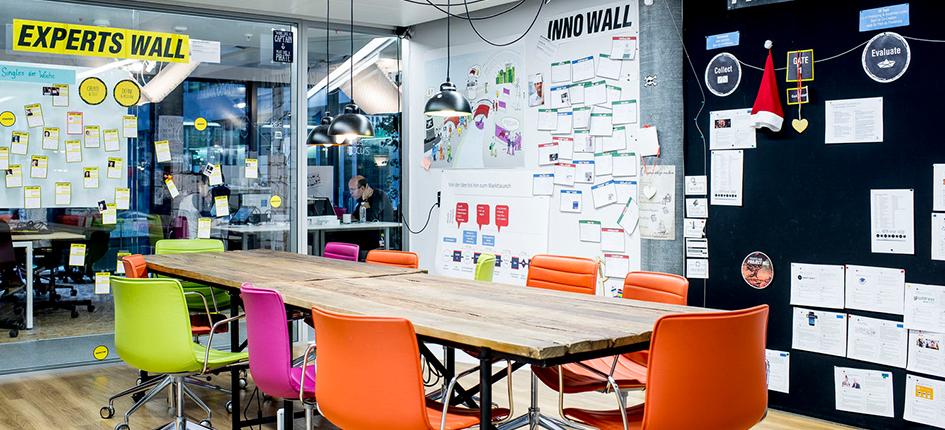Alex Osterwalder, how important is a business model for the success of an exporting SME?
The business model is the core of every enterprise. SMEs need to answer two questions: Firstly, how can I create value for my customers? This addresses the value proposition or the question: what exactly are my products and services? Secondly: how can I create value in the company? This question refers to the value chain. This is where the Business Model Canvas comes in, a strategic tool that can help visualize and explain a business model.
What do exporting SMEs need to pay attention to in particular?
In the exporting business, it is vital to be able to adapt the value proposition to the local market and the needs of the customers. For this reason, SMEs need to question and, if necessary, adjust their business model accordingly. The Dutch hotel chain CitizenM, which offers high-quality accommodations at low prices, is an example of successful localization. Its business model allows for cost reduction, yet the service quality is retained. For example, the hotels do not offer a sauna, gym, or restaurant, as these services do not represent any added value for certain travelers who do not consider them important. When CitizenM expanded to New York, the question arose whether the same concept would be successful there. The management decided not to adjust the value proposition. Today, the chain is successful in New York – even without a gym. Thus, SMEs always need to ask themselves: how can I find the right balance between adjusting a business model and preserving success factors? The dilemma is the more I adjust my business model, the less scalable it becomes – and the less I adjust it, the greater the risk that I will not be successful when exporting to certain markets.
Why is technological innovation not sufficient in global competition?
Because SMEs cannot create customer value with technology alone. Ultimately, customer are not interested in the technology in and of itself but rather in satisfying their needs. Therefore, the chances of being successful are much greater if technology is combined with the value proposition and the business model. Moreover, it is relatively easy to copy a technology, but not a business model. Apple and IKEA are the global leaders in their segments not because of their product innovation but because of their business models. The belief that innovation relates only to technology is a myth. There always needs to be interaction between technology, processes, management, and business model innovation. Especially where the latter is concerned, both SMEs and large corporations still have a lot of catching up to do. Technological innovation is just one factor – what really matters is thinking in terms of business models.
How does the digitization megatrend affect the subject of business models?
Thanks to the Internet, SMEs and even micro-enterprises can find customers in any country the world over. This is an opportunity, but it also means there is more competition. That is why the pressure to adjust business models more quickly is on the rise. Additionally, more decisions need to be made due to new technologies and channels. In the past, all enterprises in an industry used to have more or less the same business model. Nowadays, business models vary greatly. For example, consider the flight industry: today, there are budget airlines, business-class-only airlines, government airlines, fractional ownership of private jets, and private jet brokerage platforms. Business class flights are now competing with the broker business, which offers flights on unused private jets or empty legs of trips with these aircraft.
SMEs are increasingly experiencing pressure to review and further develop their business models. What happens if they fail to do so?
That would be careless – they could not survive. "Thinking in new business models" is not expensive and does not require any major investments. What costs money is research and development. Innovation means finding new ways to create value for my customers or introducing new business models.
What does it mean to think in business models?
To think in business models means to systematically review every aspect of the business model over and over again. SMEs should ask themselves: can I develop something new, build a new portfolio, or develop a business model for the future? This process can be tackled systematically with the help of tools and methods. 20 years ago, people spoke of business process reengineering and tried to streamline existing business models and optimize operational processes. This approach has now reached its limits. Today's business model might become irrelevant tomorrow, because even business models have an expiration date, so to say, and will ultimately perish like milk in a refrigerator.
Swiss SMEs have a different mentality than start-ups in Silicon Valley. Is the ability to think in business models a question of mentality?
Yes, it is. However, the main issue is not comparing the mentalities of Swiss SMEs and start-ups in Silicon Valley. Instead, it is necessary to compare enterprises that are currently successful with those that regularly and systematically review and further develop their business models in a targeted manner. Swiss SMEs and large corporations are champions in optimizing processes and products and conquering new markets. In other words: they are champions in streamlining tried-and-tested, established business models. However, they are not as good at inventing new products, services, or business models. The latter requires a different mentality because something that is effective and works well represents the greatest danger for the future. This is because it is difficult to critically examine the business as long as it is successful. Internally, companies need a corporate culture in which employees can experiment with new offers and business models.
How should SMEs promote innovation?
Most importantly, they need to focus on the customer. It sounds simple, but actually many companies are shifting their focus further and further away from the customer while processes and internal discussions increasingly occupy a central position. Start-ups test their products on their customers at an early stage. They need to do so in order to survive. By contrast, SMEs and especially large corporations first prepare a business plan in which they describe how an idea is to be implemented. Such an approach eliminates any leeway for innovation. Instead of composing a business plan in the initial phase, SMEs should test ideas on customers. Business plans are not suitable for a new offer or a new business model because they describe something that has not been implemented yet. Testing ideas also means recognizing when something does not work: if I interview 100 customers and 90 of them dislike my idea, the only thing I will have lost is the time spent for the interviews. If I had implemented the idea right away and had failed, I would have lost a whole lot of money.
So what should SMEs do?
They should invest in learning methods and in the skills of their employees. There are numerous tools for this, some of which are even available free of charge on the Internet. People do not need to attend a renowned business school, but they do need to invest time. If I am the manager of an SME, I need to find someone in the company who has a certain affinity for the subject and give the individual time to develop ideas. And people and companies also need time to test the ideas before rolling them out on a large scale.
In the field of innovation, SMEs can achieve a lot if they systematically establish functions or areas that focus on the future. Compared to large corporations, SMEs, which are not under pressure to deliver quarterly reports, have the great advantage of being able to think for the longer term.
Alexander Osterwalder
Dr. Alexander Osterwalder, born in 1974 in St. Gallen, is an author and co-founder of Strategyzer AG. He developed his application-oriented business model design approach (Business Model Canvas) in collaboration with Dr. Yves Pigneur, professor at the University of Lausanne. In 2000, Osterwalder received his Master of Arts in Political Sciences from the University of Lausanne. In 2004, he obtained his PhD in Management Information Systems from the same university.
More information at: strategyzer.com/
Business Model Canvas
The Business Model Canvas is a strategic tool that can be used to visualize any business model. It consists of nine building blocks that are valid for every business model: the customer segment, the value proposition, the channels used to read customers, the customer relationships, the revenue streams, the key resources, the key activities, the key partnerships, and the cost structure. The Business Model Canvas can be used to draw up, discuss, and further develop any possible business model until the individual components are perfectly coordinated with each other.
More information
Forum for Swiss Foreign Trade 2017
Would you like to learn more about how exporting SMEs are adapting to the digital transformation and rethinking their business models? More on this topic at this year's Forum for Swiss Foreign Trade.
You can find more inspiring articles and interviews in our dossier on transforming business models.






